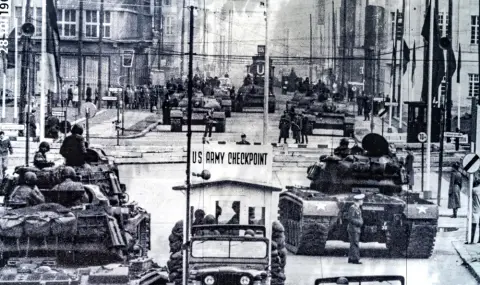All of Germany looks like a huge ruin. After the end of World War II, the entire country is destroyed, but people hope for better times. At the same time, the shadow of the Cold War is already hanging over the country's reconstruction.
The victors in the war begin to suspiciously stalk each other. On one side are the USA, Great Britain and France, on the other - the Soviet Union. Germany is divided into occupation zones. The capital Berlin is also divided. In the city, the tension between the former allies is particularly palpable.
Two million people live in the three western sectors of Berlin - on a sort of island in the middle of the Soviet occupation zone in East Germany.
The crisis caused by the introduction of the German mark
On June 20, 1948, the West and the East came to an open showdown. The Western Allies decided on a currency union: the birth of the West German mark. Germany was to be put on its feet with the help of a strong, hard currency. The West mark was also introduced in West Berlin, but Soviet dictator Stalin feared that this would strengthen the city as a bridgehead for the Western powers to all of Berlin and East Germany.
"This led to a rift between the Western Allies and the Soviet command," explains historian Bernd von Kostka. "A common policy towards Germany has been difficult until now, but with the monetary union it becomes downright impossible."
On the night of June 24, the Soviets blocked all the arteries to West Berlin. Soon darkness fell there, because three-quarters of the electricity came from outside. Stalin's regime wanted to drain West Berlin to push the Western Allies out of the city. But they refused. The United States considered West Berlin a key factor in the fight for freedom and democracy - and a barricade against the advance of communism.
West Berlin - a frontline in the fight for freedom
And time was running out: West Berliners were literally threatened with starvation. That is why US President Harry Truman, after an agreement with the Allies, decided on a truly sensational operation. The two million citizens of West Berlin would now be supplied with food only by air, with planes flying along three corridors guaranteed by the Soviet Union. At first, this plan seemed absolutely impossible, but there was simply no alternative, explains von Kostka.
On June 26, the first US Air Force planes took off from bases in Frankfurt am Main and Wiesbaden to West Berlin's Tempelhof Airport. Soon, the planes were flying every minute and a half, landing first at one and later at two more airports in West Berlin.
The citizens of West Berlin needed 5,000-6,000 tons of food and coal every day. The operation to supply them reached its peak in April 1949, when 13,000 tons of cargo were delivered to the besieged city within 24 hours and 1,500 flights. The pilots carrying out the airlift flew constantly. They were often mortally tired and risked their lives to land in West Berlin regardless of the weather. Several planes had accidents.
Chocolates and chewing gum for the children
The propeller-driven planes, which Berliners called "raisin bombers", often flew so low over residential buildings when landing that the crews and people on the ground could even wave. Some of the pilots threw homemade parachutes with chocolates and chewing gum for the children below.
The transfer of this airlift marked the beginning of the warming of the otherwise quite tense relations between the American occupation forces and the German population. "A friend of the occupation forces told me that before the bridge, when they entered a restaurant, the locals would get up and leave. But once we started supplying Berlin with food, we were already welcome. And that's fantastic. The enemies became friends," says former US Air Force pilot Gale Halvorson in his memoirs.
It was not only the bravery and skill of the Allied pilots that were decisive, but also the endurance of the West Berliners. At that time, households there had electricity for only one hour a day, because the coal for the power plants came by air. The electricity regime was variable, so in some cases the only time to prepare a hot meal was in the middle of the night. There was no mention of heating. "The population was subjected to monstrous deprivation," summarizes the Swiss historian Walter Hofer.
The airlift gained the Allies more and more sympathy on the international stage, while the authority of the Soviet Union began to decline due to the imposed blockade. In the end, Stalin was forced to realize that he would not win this muscle test and after 322 days, on May 12, 1949, he lifted the blockade. During this nearly year, 260,000 planes landed in West Berlin, delivering over two million tons of food and other goods to the population. The airlift was officially terminated on September 30, 1949 - exactly 75 years ago.
Stalin's Historical Mistake
"Stalin achieved the exact opposite of his goal of preventing the emergence of a West German state. On the contrary - its creation was accelerated, NATO also appeared, the integration of the Western world began to gain momentum. The blockade of West Berlin is one of the biggest mistakes made by any politician in human history," says historian Walter Hofer.
And the Germans suddenly feel accepted again in the community of values of the Western world. And they now see the Allies not so much as occupiers as protectors, explains historian von Kostka.
He believes that this air bridge is also the basis of today's international cooperation in conditions of humanitarian catastrophes, in areas of conflict and crisis. "It turned out that air supplies work. And today's planes have such a high load capacity that those supplies can now be carried out with much fewer flights - and to any point in the world."
Author: Ralf Bose
